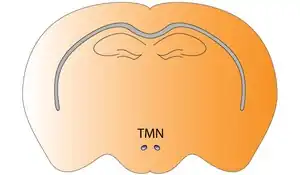| Tuberomammillary nucleus | |
|---|---|
 Tuberomammillary nucleus of the mouse brain | |
| Details | |
| Part of | Hypothalamus |
| Identifiers | |
| Latin | Nucleus tuberomamillaris |
| Acronym(s) | TMN |
| NeuroNames | 427 |
| NeuroLex ID | birnlex_1271 |
| TA98 | A14.1.08.932 |
| TA2 | 5734 |
| FMA | 62335 |
| Anatomical terms of neuroanatomy | |
The tuberomammillary nucleus (TMN) is a histaminergic nucleus located within the posterior third of the hypothalamus.[1] It is part of the tuber cinereum.[2] It largely consists of histaminergic neurons (i.e. histamine-releasing neurons). It is involved with the control of arousal, learning, memory, sleep and energy balance.[1]
Efferents
The tuberomammillary nucleus is the sole source of histamine pathways in the human brain. The densest axonal projections from the tuberomammillary nucleus are sent to the cerebral cortex, hippocampus, neostriatum, nucleus accumbens, amygdala, and other parts of the hypothalamus.[1] The projections to the cerebral cortex directly increase cortical activation and arousal, and projections to acetylcholinergic neurons of the basal forebrain and dorsal pons do so indirectly, by increasing the release of acetylcholine in the cerebral cortex.
References
- 1 2 3 Malenka RC, Nestler EJ, Hyman SE (2009). "Chapter 6: Widely Projecting Systems: Monoamines, Acetylcholine, and Orexin". In Sydor A, Brown RY (eds.). Molecular Neuropharmacology: A Foundation for Clinical Neuroscience (2nd ed.). New York: McGraw-Hill Medical. pp. 175–176. ISBN 9780071481274.
Within the brain, histamine is synthesized exclusively by neurons with their cell bodies in the tuberomammillary nucleus (TMN) that lies within the posterior hypothalamus. There are approximately 64000 histaminergic neurons per side in humans. These cells project throughout the brain and spinal cord. Areas that receive especially dense projections include the cerebral cortex, hippocampus, neostriatum, nucleus accumbens, amygdala, and hypothalamus. ... While the best characterized function of the histamine system in the brain is regulation of sleep and arousal, histamine is also involved in learning and memory ... It also appears that histamine is involved in the regulation of feeding and energy balance.
- ↑ Braak, Heiko; Braak, Eva (1992), Chapter 1 Anatomy of the human hypothalamus (chiasmatic and tuberal region), Progress in Brain Research, vol. 93, Elsevier, pp. 3–16, doi:10.1016/s0079-6123(08)64559-8, ISBN 978-0-444-89538-7, PMID 1480754, retrieved 2023-08-14